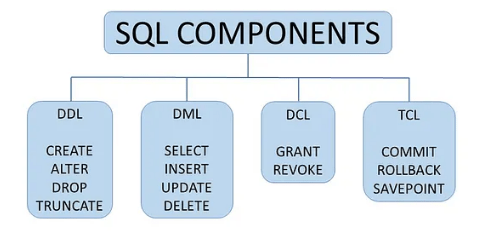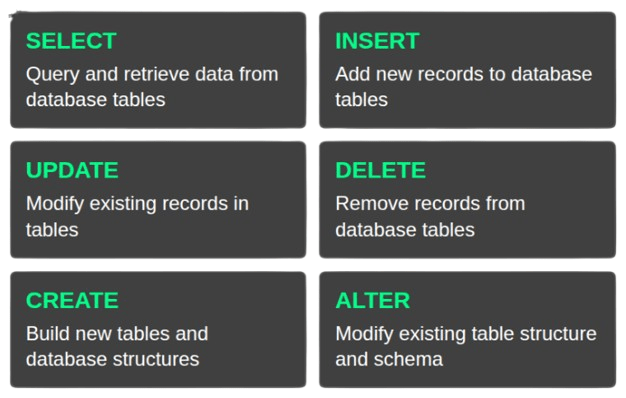
- Introduction
- What is DCL in SQL?
- Key Components of DCL
- Differences Between DCL and Other SQL Commands
- Importance of DCL in Database Security
- Common Use Cases of DCL
- Limitations and Considerations
- Conclusion
Introduction
In the landscape of relational database systems, Structured Query Language (SQL) forms the foundation for interacting with databases. SQL is categorized into several types of commands, including Data Definition Language (DDL), Data Manipulation Language (DML), Transaction Control Language (TCL), and Data Control Language (DCL). Among these, DCL plays a crucial yet often understated role. While DDL is used to create and modify the structure of database objects such as tables and indexes, and DML is used to insert, update, delete, or retrieve data within those structures, DCL focuses on controlling access to the data itself. Database Training is concerned with defining who is allowed to interact with specific data and what actions they are permitted to perform. DCL commands like GRANT and REVOKE help database administrators assign or withdraw user privileges. These privileges determine what operations a user can carry out, such as selecting records from a table or updating specific fields. This control is essential in environments where data security, confidentiality, and integrity are critical. Organizations that manage sensitive information or that are subject to regulatory requirements rely on DCL to enforce strict access controls and prevent unauthorized actions. DCL also supports role-based access, making it easier to manage permissions by grouping users with similar responsibilities. This simplifies security management in systems with many users and complex access needs. In modern data-driven environments where privacy and protection are top priorities, the importance of DCL continues to grow. Although it may not directly handle the creation of structures or the manipulation of data, its role in protecting that data is vital. DCL ensures that access is appropriately managed, forming a key part of any secure and well-governed SQL-based database system.
Interested in Obtaining Your Database Certificate? View The Database Online Training Offered By ACTE Right Now!
What is DCL in SQL?
Data Control Language (DCL) is a key component of Structured Query Language (SQL) that is specifically designed to control access to data within a database. Unlike other SQL command categories that focus on defining structures or manipulating data, DCL is concerned with setting and managing user permissions. It includes two primary commands: GRANT, which is used to provide specific access privileges to users, and REVOKE, which is used to remove those privileges when necessary, as outlined in the MongoDB Commands Cheat Sheet. These commands do not modify the actual data in the database but instead define what actions users are allowed to perform on that data. For example, a user may be granted permission to read data from a table but not to update or delete it. DCL commands are essential for ensuring database security and proper user management.

They help database administrators enforce access controls, preventing unauthorized users from viewing or altering sensitive information. This is especially important in environments that require strict compliance with data privacy regulations or that handle confidential business or customer data. By defining precise user roles and access levels, DCL contributes to maintaining the integrity, confidentiality, and reliability of the database. DCL is widely supported by most relational database management systems, including MySQL, PostgreSQL, Oracle, and Microsoft SQL Server. Typically, these commands are used by database administrators (DBAs), who are responsible for assigning roles, managing access rights, and monitoring database security. The ability to control who can access or manipulate specific data ensures that the database environment remains secure and organized. In today’s data-driven world, where information security is a top priority, DCL plays an indispensable role in upholding trust and protecting valuable digital assets.
Key Components of DCL
- GRANT: The GRANT command is used to assign specific privileges to users or roles. These privileges can include access to tables, schemas, or operations like SELECT, INSERT, UPDATE, or DELETE.
- Purpose of GRANT: It enables controlled access to data and administrative capabilities, ensuring that users have only the permissions they need in the context of DBMS vs RDBMS vs NoSQL.
- Example of GRANT Usage: A user might be granted permission to read and insert records into an employees table, allowing them to perform these operations safely.
- REVOKE: The REVOKE command removes privileges that were previously granted to a user or role. This is important when roles change, users leave, or access needs to be restricted.
- Purpose of REVOKE: It helps maintain security by ensuring that users do not retain permissions they no longer require, reducing risk of unauthorized data changes.
- Scope of Application: Both GRANT and REVOKE commands can apply to individual users, groups (roles), or even to all users in the system, often referred to as PUBLIC.
- Importance in Database Security: Proper use of GRANT and REVOKE commands is essential to enforce access control policies, protect sensitive information, and maintain organizational compliance.
- Purpose: DCL (Data Control Language) manages permissions and access rights, whereas DDL (Data Definition Language) defines database structures, and DML (Data Manipulation Language) handles data operations like insert, update, and delete.
- Key Commands: Database Training includes topics like DCL, which mainly includes GRANT and REVOKE to control user privileges, and DDL, which includes commands like CREATE, ALTER, and DROP for schema changes.
- Effect on Data: DCL does not modify the data or structure itself but controls who can perform those actions. DDL changes the database schema, while DML changes the data stored inside tables.
- Transaction Behavior: DCL commands typically require explicit commit or rollback to finalize permission changes, unlike DDL commands which are auto-committed immediately.
- Use Case: DCL is used for security and user management, DDL is used during database design and restructuring, and DML is used daily for data querying and updates.
- Scope: DCL commands affect user access and security policies across the database or specific objects. DDL commands impact the physical structure, and DML commands affect actual data records.
- Frequency of Use: DCL commands are used less frequently compared to DDL and DML since permission changes happen mainly during setup or role changes, whereas DDL and DML are used regularly in database operations.
- Role-based access: This approach assigns specific permissions based on job roles. For example, data analysts might get read-only access to reports, developers get modification rights on development databases, and admins have full control.
- Department-specific access: Access can be tailored by department, so HR staff can view and manage employee records while finance teams are restricted from sensitive personnel data. This segmentation protects sensitive information and supports organizational hierarchy.
- Temporary access: Sometimes users need time-limited privileges for special tasks like audits or short-term projects. In the context of Cassandra Vs MongoDB, granting temporary access ensures security while allowing flexibility, with automatic revocation after the designated period.
- Revoking ex-employee privileges: When employees leave, promptly revoking their access prevents unauthorized data access or manipulation. This is critical for maintaining security and complying with company policies.
- Object-level control: Permissions can be granted not just at the table level but down to specific database objects such as views, stored procedures, or functions. This granular control enables tighter security and reduces exposure of sensitive data.
- Compliance enforcement: Access control policies help organizations comply with legal requirements like GDPR, HIPAA, or industry certifications. Properly enforced DCL commands ensure that only authorized users can access or modify sensitive data.
- Audit trails and accountability: DCL facilitates tracking who has been granted or revoked permissions. This auditing supports transparency and accountability in database security management.
To Earn Your Database Certification, Gain Insights From Leading Blockchain Experts And Advance Your Career With ACTE’s Database Online Training Today!
Differences Between DCL and Other SQL Commands

Importance of DCL in Database Security
Data Control Language (DCL) is central to enforcing data privacy, integrity, and accountability within a database system. It provides the essential framework for controlling who can access or manipulate data, playing a critical role in maintaining secure and compliant database environments. Without DCL, every user would potentially have unrestricted access to all data and operations, which could result in serious consequences such as security breaches, data leaks, unauthorized modifications, and failure to comply with regulatory standards. DCL helps prevent these risks by enabling database administrators to define and enforce access rules based on specific roles and responsibilities. Using DCL commands like GRANT and REVOKE, administrators can ensure that only authorized personnel have access to specific tables, views, or operations in Types of Joins in SQL Server. Access can be assigned based on the principle of least privilege, meaning users are granted the minimum level of access necessary to perform their tasks. This minimizes the attack surface and reduces the likelihood of accidental or malicious data exposure. In addition, DCL supports the creation of audit trails, making database activities more transparent and trackable. This is especially important in multi-user environments where monitoring and accountability are essential. DCL also contributes to protecting sensitive data from misuse, making it an important tool for compliance with data protection regulations such as the General Data Protection Regulation (GDPR), the Health Insurance Portability and Accountability Act (HIPAA), and the Payment Card Industry Data Security Standard (PCI-DSS). By applying DCL consistently and strategically, organizations can uphold high standards of data security while ensuring they meet both internal governance policies and external regulatory requirements. Overall, DCL is a foundational component of any secure and well-managed database system.
Are You Interested in Learning More About Database? Sign Up For Our Database Online Training Today!
Common Use Cases of DCL
Limitations and Considerations
Despite its critical role in securing database environments, Data Control Language (DCL) has several limitations that can affect its effectiveness in certain scenarios. One of the main limitations is the lack of fine-grained control. Basic DCL does not support condition-based or row-level access restrictions, which means administrators cannot easily enforce rules that allow access to specific records within a table based on user roles or conditions. While some modern database systems offer row-level security features, these are typically implemented outside of standard DCL. Another challenge is the variation in DCL syntax and capabilities across different SQL database vendors. For example, the way permissions are granted or revoked may differ between MySQL, PostgreSQL, Oracle, and Schema in SQL Server, making it harder to maintain consistent security policies in environments that use multiple systems. Additionally, DCL provides limited native support for auditing. Unless configured explicitly, not all permission changes are logged automatically, which can make it difficult to track historical access modifications or diagnose security issues. Time-based permission control is also lacking in standard DCL. There is no built-in mechanism to automatically expire or revoke access rights after a certain period. Administrators must rely on manual intervention or external scripts to manage temporary permissions. This adds operational overhead and increases the risk of permissions remaining in place longer than necessary. Furthermore, DCL requires careful oversight by database administrators. Mistakes such as granting overly broad access can unintentionally expose sensitive data. Since DCL commands are not executed as frequently as DML operations, they can be overlooked during change management processes, potentially leading to outdated or insecure permission settings. These limitations highlight the importance of complementing DCL with additional security practices and tools to maintain a robust database security posture.
Preparing for a Database Job Interview? Check Out Our Blog on Database Interview Questions and Answers
Conclusion
Data Control Language (DCL) may include only two main commands, GRANT and REVOKE, but their impact on database operations is profound. These commands form the foundation of access control within SQL-based systems. DCL ensures that the right users have appropriate access to perform specific actions on data, and more importantly, that unauthorized users are restricted from accessing or manipulating sensitive information. It acts as a critical layer of defense that supports data privacy, system integrity, and operational accountability across all types of database environments. In an era where data sensitivity is high, compliance obligations are strict, and cybersecurity risks continue to grow, understanding DCL is not just a useful technical skill but a necessary part of responsible data management. From protecting health records in medical systems to managing access to customer data in enterprise platforms, Database Training emphasizes how DCL plays a key role in safeguarding digital assets. It allows database administrators and system architects to apply security policies, enforce the principle of least privilege, and help organizations meet regulations like GDPR, HIPAA, and PCI-DSS. Learning and applying DCL is important not only for database administrators but also for developers, data analysts, and anyone involved in database management. Even beginners exploring SQL can benefit from understanding how DCL fits into the broader picture of database security. By gaining this knowledge, professionals are better equipped to design and maintain systems that are both functional and secure. DCL may seem simple on the surface, but its real-world impact is substantial. It is an essential part of building systems that are secure, trustworthy, and aligned with modern data governance standards.


